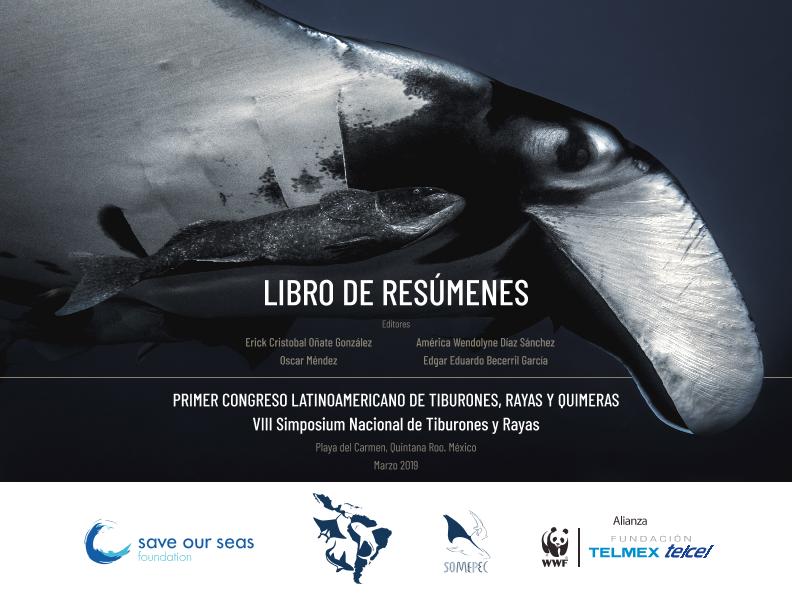Mostrar el registro sencillo del ítem
dc.contributor.author
Moya, Ana Carolina

dc.contributor.author
Awruch, Cynthia Andrea

dc.contributor.author
Galíndez, Elena Juana

dc.contributor.author
Somoza, Gustavo Manuel

dc.contributor.other
Castillo Géniz, José Leonardo
dc.date.available
2023-08-03T13:04:16Z
dc.date.issued
2019
dc.identifier.citation
Estudios preliminares de la relación entre la morfología del encéfalo y los patrones ecológicos de los batoideos (Rajidae): La raya marmorada, Sympterygia bonapartii; Primer congreso latinoamericano de tiburones, rayas y quimeras y VIII Simposium nacional de tiburones y rayas; Playa del Carmen; México; 2019; 157-157
dc.identifier.uri
http://hdl.handle.net/11336/206765
dc.description.abstract
Elasmobranchs are an evolutionarily conserved group, with very high impact on aquatic ecosystems. They are the first group to exhibit brain morphology homologous to those of tetrapods and they are excellent models that provide new perspectives on the evolution of ancestral neural systems link to their habitat. The batoids are unique amongst elasmobrachs that have morphological specializations to a benthic niche. In this context, the aim is this study was to use Sympterygia bonapartii as a study model to describe the brain organization and to explore the relationships between the neuronal organization and the ecological patterns in this group. This species extends from Southern Brazil to Argentina, from shoreline down to 100 m depth and is one of the most disembarked elasmobranch in the commercial harbors. They are oviparous and use mainly the estuarine waters for mating, giving birth and as a breeding ground. This work describes the macroscopical and microscopial morphology of the brain in S. bonapartii. Samples were fixed in Bouin?s fixative in seawater, dehydrated and embedded in Paraplast®. Sections of 5-7 µm were stained with hematoxylin-eosin and Bielschowsky silver stain. Macroscopically, the brain included telencephalon, diencephalon, mesencephalon, smooth unfoliated cerebellum, and a large medulla oblongata. Microscopically, the telencephalon is a solid structure, with groups of granular cells interspersed in a mass of glial cells that conform the nervous tissue. In the diencephalon area, hypothalamus is enlarged and well developed. The pituitary gland is divided into three regions: the rostral and proximal pars distalis, with acidophilic and basophilic cells and a large neuro-intermediate lobe, close to the saccus vasculosus. The cerebellum architecture is similar to other vertebrates. This first brain morphology analysis shows that the pattern of organization in S. bonapartii, agrees with that seen in other Batoids with similar ecological arranges included them in a benthic cerebrotype.
dc.format
application/pdf
dc.language.iso
spa
dc.publisher
Sociedad mexicana de peces cartilaginosos
dc.rights
info:eu-repo/semantics/openAccess
dc.rights.uri
https://creativecommons.org/licenses/by-nc-sa/2.5/ar/
dc.subject
SYMPTERYGIA BONAPARTII
dc.subject
ENCÉFALO
dc.subject
BATOIDEOS
dc.subject
PATRONES ECOLÓGICOS
dc.subject.classification
Otras Ciencias Biológicas

dc.subject.classification
Ciencias Biológicas

dc.subject.classification
CIENCIAS NATURALES Y EXACTAS

dc.title
Estudios preliminares de la relación entre la morfología del encéfalo y los patrones ecológicos de los batoideos (Rajidae): La raya marmorada, Sympterygia bonapartii
dc.type
info:eu-repo/semantics/publishedVersion
dc.type
info:eu-repo/semantics/conferenceObject
dc.type
info:ar-repo/semantics/documento de conferencia
dc.date.updated
2023-03-28T15:00:24Z
dc.journal.volume
1
dc.journal.number
1
dc.journal.pagination
157-157
dc.journal.pais
México

dc.journal.ciudad
Playa del Carmen
dc.description.fil
Fil: Moya, Ana Carolina. Consejo Nacional de Investigaciones Científicas y Técnicas. Centro Científico Tecnológico Conicet - Bahía Blanca. Instituto de Ciencias Biológicas y Biomédicas del Sur. Universidad Nacional del Sur. Departamento de Biología, Bioquímica y Farmacia. Instituto de Ciencias Biológicas y Biomédicas del Sur; Argentina
dc.description.fil
Fil: Awruch, Cynthia Andrea. Consejo Nacional de Investigaciones Científicas y Técnicas. Centro Científico Tecnológico Conicet - Centro Nacional Patagónico; Argentina
dc.description.fil
Fil: Galíndez, Elena Juana. Consejo Nacional de Investigaciones Científicas y Técnicas. Centro Científico Tecnológico Conicet - Bahía Blanca. Instituto de Ciencias Biológicas y Biomédicas del Sur. Universidad Nacional del Sur. Departamento de Biología, Bioquímica y Farmacia. Instituto de Ciencias Biológicas y Biomédicas del Sur; Argentina
dc.description.fil
Fil: Somoza, Gustavo Manuel. Universidad Nacional de San Martin. Instituto Tecnologico de Chascomus. - Consejo Nacional de Investigaciones Cientificas y Tecnicas. Centro Cientifico Tecnologico Conicet - la Plata. Instituto Tecnologico de Chascomus.; Argentina
dc.relation.alternativeid
info:eu-repo/semantics/altIdentifier/url/https://somepec.org/wp-content/uploads/2019/04/Memorias-del-Primer-Congreso-Lationamericano-y-VIII-SNTYR.pdf
dc.conicet.rol
Autor

dc.conicet.rol
Autor

dc.conicet.rol
Autor

dc.conicet.rol
Autor

dc.coverage
Internacional
dc.type.subtype
Congreso
dc.description.nombreEvento
Primer congreso latinoamericano de tiburones, rayas y quimeras y VIII Simposium nacional de tiburones y rayas
dc.date.evento
2019-03-25
dc.description.ciudadEvento
Playa del Carmen
dc.description.paisEvento
México

dc.type.publicacion
Book
dc.description.institucionOrganizadora
Sociedad mexicana de peces cartilaginosos
dc.source.libro
Memorias del primer congreso latinoamericano de tiburones, rayas y quimeras y VIII Simposium nacional de tiburones y rayas
dc.date.eventoHasta
2019-03-29
dc.type
Congreso
Archivos asociados
